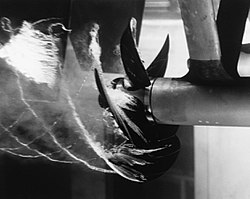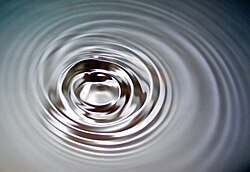Liquid
A liquid is a form of matter. It is settled between solid and gas. Liquid has an almost-fixed volume, but no set shape.[1]
Every small force makes a liquid change its shape by flowing. Because of that, gravity makes liquids always take the shape of the container. The molecules that make up the liquid can freely move among themselves.[2]
Fluids that flow slowly have a high viscosity.[3] Some fluids like tar have such a high viscosity that they may seem solid.[4]
It is difficult (near impossible) to compress a liquid. If a liquid is cooled down until it is colder than a certain temperature, it will become a solid. This temperature is called the melting point or freezing point and is different for every different type of liquid. If a liquid is heated up it becomes a gas. The temperature this happens at is called the boiling point.
Examples of liquid are water, oils, tar and blood.
In a liquid, the liquid on the top presses down on the liquid underneath, so at the bottom the pressure, p, is bigger than at the top. The equation for working this out is:
- p = ρgz
where z is the depth of the point below the surface and g is how strong gravity is pulling on the liquid. ρ is a number that tells us how heavy a set amount of the liquid is. We call this the density and it is different for all liquids.
Liquid Media
The formation of a spherical droplet of liquid water minimizes the surface area, which is the natural result of surface tension in liquids.
Surface waves in water
A simulation of viscosity. The fluid on the left has a lower viscosity and Newtonian behavior while the liquid on the right has higher viscosity and non-Newtonian behavior.
Radial distribution function of the Lennard-Jones model fluid
A typical phase diagram. The dotted line gives the anomalous behaviour of water. The green lines show how the freezing point can vary with pressure, and the blue line shows how the boiling point can vary with pressure. The red line shows the boundary where sublimation or deposition can occur.
A lava lamp contains two immiscible liquids (a molten wax and a watery solution) which add movement due to convection. In addition to the top surface, surfaces also form between the liquids, requiring a tension breaker to recombine the wax droplets at the bottom.
References
- ↑ "Definition of liquid - Chemistry Dictionary". chemicool.com. Retrieved 22 March 2010.
- ↑ "Definition of Liquid". brainyquote.com. Retrieved 22 March 2010.
- ↑ "Teacher Page: Viscosity". spacegrant.hawaii.edu. Archived from the original on 2 February 2010. Retrieved 23 March 2010.
- ↑ "Can you compress a liquid (water)?". physlink.com. Retrieved 23 March 2010.
Other websites
- "Phases of Matter". NASA. Archived from the original on 2009-10-30. Retrieved 2011-05-04.








